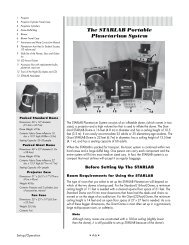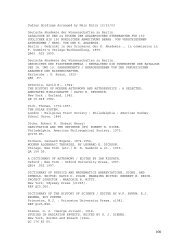K-6 Activities - Dudley Observatory
K-6 Activities - Dudley Observatory
K-6 Activities - Dudley Observatory
Create successful ePaper yourself
Turn your PDF publications into a flip-book with our unique Google optimized e-Paper software.
K–6 <strong>Activities</strong> • B–54 •<br />
Elementary Grades 4-6 Objectives<br />
Objectives — Grade 4<br />
The student should be able to:<br />
1. Identify the cardinal directions and locate the North Star in the planetarium.<br />
2. Describe the general east to west movement of the sun, stars, and moon.<br />
3. Observe and describe the apparent motion of the Big Dipper in relation to the<br />
North Star over a period of several hours.<br />
4. Observe and discuss the concept that stars continually shine but may not be seen<br />
by the naked eye due to other stronger light sources.<br />
5. Observe and describe the movement of constellations.<br />
6. Demonstrate that constellations are merely imaginary star groupings that are not<br />
connected in any physical way.<br />
7. Identify the circumpolar constellations, using the Constellation Cylinder in<br />
STARLAB.<br />
Objectives — Grade 5<br />
The student should be able to:<br />
1. Compare and discuss the work of early astronomers Copernicus, Galileo, Ptolemy.<br />
2. Describe the phases of the moon in 5 stages (new to full).<br />
3. Observe and discuss the major constellations not covered at previous levels, using<br />
the Constellation Cylinder within the STARLAB.<br />
4. Describe the comparative positions of the circumpolar stars in a given 24-hour<br />
period.<br />
5. Describe the relative positions of the circumpolar stars during different seasons.<br />
6. Demonstrate why the North Star does not appear to change its relative position<br />
in the sky.<br />
7. Demonstrate an understanding that celestial bodies appear to move in a regular<br />
path through the universe “dome.”<br />
Objectives — Grade 6<br />
The student should be able to:<br />
1. Compare and discuss the work of some early astronomers. Review 5th level<br />
astronomers and add Tycho Brahe, Kepler, and Eratosthenes.<br />
2. Describe the relative changes in the sunrise and sunset times over one year.<br />
3. Demonstrate an understanding of the reasons for the apparent motion of the<br />
stars.<br />
4. Demonstrate an understanding of the seasonal changes in stellar locations due to<br />
the revolution of the earth around the sun.<br />
5. Demonstrate an understanding of the differences in stellar motion as observed<br />
from the equator versus the polar regions.<br />
6. Identify four major stellar reference points used in locating and describing positions<br />
of other stellar bodies.





